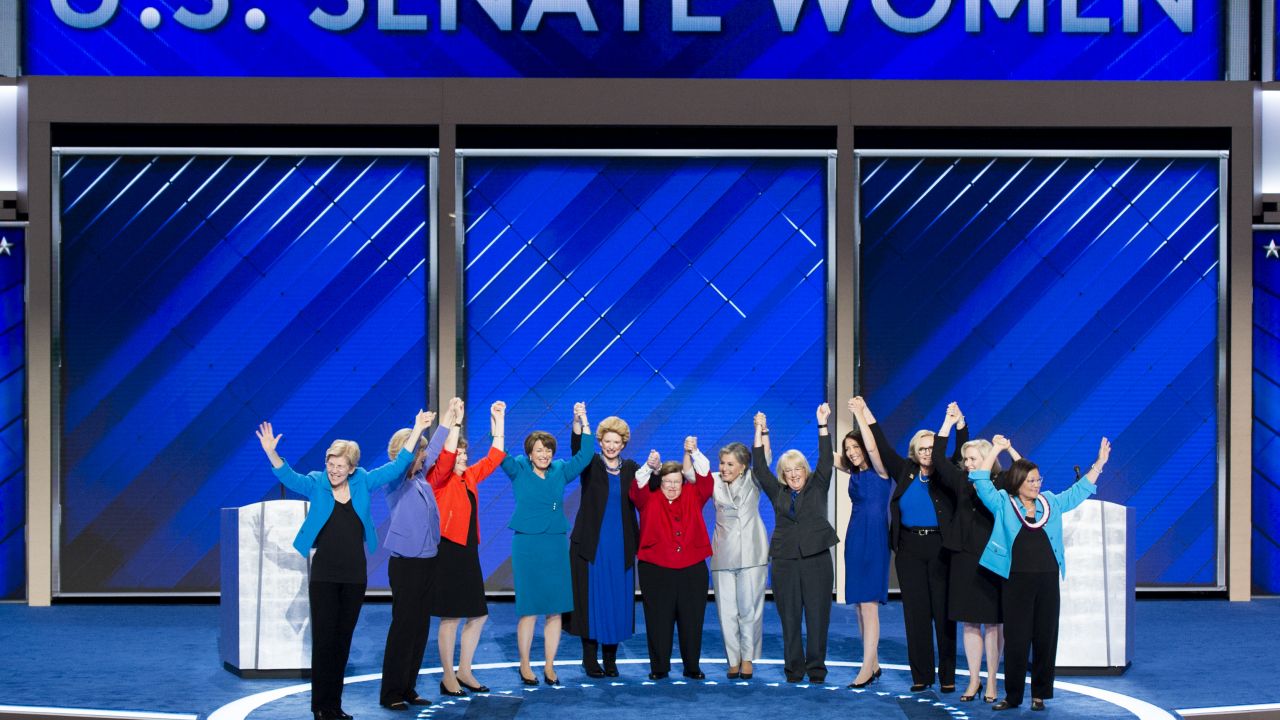
From left, Sen. Elizabeth Warren (D-MA), Sen. Tammy Baldwin (D-WI), Sen. Jeanne Shaheen (D-NH), Sen. Amy Klobuchar (D-MN), Sen. Debbie Stabenow (D-MI), Sen. Barbara Mikulski (D-MD), Sen. Barbara Boxer (D-CA), Sen. Patty Murray (D-WA), Sen. Maria Cantwell (D-WA), Sen. Claire McCaskill (D-MO), Sen. Kirsten Gillibrand (D-NY) and Sen. Mazie Hirono (D-HI) wave on stage for the US Senate Women presentation at the Democratic National Convention in Philadelphia on Thursday, July 28, 2016. (Photo By Bill Clark/CQ Roll Call)
This post originally appeared at The American Prospect.
Americans might not only elect their first woman president in November; they might also install a record number of women in the 100-member Senate.
There are currently 20 women in the Senate — 14 Democrats and six Republicans — according to the Center for American Women and Politics at Rutgers University.
Twelve women — including three incumbents — are currently running for 10 Senate seats. (There are 34 Senate races this year).
If things break well for the Democrats, the next Senate could have 24 women — 19 Democrats and five Republicans. This would be a record number of women in the Senate.
Public opinion about women running for public office has changed dramatically over the last several decades, according to Gallup surveys. In 1937, only 33 percent of Americans said they would vote for a “qualified” woman for president. By 1955, a majority (52 percent) of Americans first told Gallup pollsters that they would be willing to vote for a “qualified” woman for president. By 1971, the figure had had grown to 66 percent and by 1978 it had increased to 75 percent. By 1999, a full 92 percent embraced the idea of a possible female president. That figure hasn’t budged since, according to a Gallup survey conducted last year, but it is likely to increase slightly in the future, because among current 18-to-29-year-olds, support for the idea of a woman president stands at 96 percent, Gallup found.
Since the 1970s, the number of women in Congress and in other levels of government has steadily grown. Women now comprise 20 percent of the Senate, 19.3 percent of House members, 24.6 percent of state legislators, 12 percent (six) of the nation’s 50 governors and 19 percent of the mayors of the nation’s 100 largest cities. Even so, American women still are still far less represented in government than their international peers.
It wasn’t until the 1990s that women began to make inroads in the US Senate. The number of women in the Senate grew from two to nine between 1989 and 1999. By 2001, the figure had jumped to 14 and by 2013 it had grown to 20, where it stands now.
Donald Trump has accused Hillary Clinton of “playing the woman’s card.” Indeed, as the first woman running for president as a major political party nominee, Clinton will likely win a higher proportion of women voters than any other presidential candidate in history. But her name on the top of the ticket is also likely to help this year’s Democratic female congressional candidates. Clinton can be expected to boost turnout among female voters who disproportionately vote for Democrats. Donald Trump’s unpopularity among women from both parties also has the potential help female Democratic candidates for Senate. A Gallup poll earlier this year found that 70 percent of women have an unfavorable opinion of Trump. Although some Republican Senate candidates have sought to distance themselves from Trump — New Hampshire Sen. Kelley Ayotte, for example, says she’ll vote for him but has refused to endorse him — Democratic candidates will do their best to hang Trump around their GOP opponents’ necks.
Three female incumbents — Alaska Republican Lisa Murkowski, Washington state Democrat Patty Murray and Ayotte — are running for re-election. Murkowski and Murray are shoo-ins to win, but Ayotte is facing a tough challenge from current Democratic Governor Maggie Hassan, who is currently ahead in the polls.
Additionally, two female senators — Democrats Barbara Boxer of California and Barbara Mikulski of Maryland — are retiring. It looks certain that one of them will be replaced by a woman, and the other will be replaced by a man. Both candidates running to replace Boxer are Democratic women. Polls show that state Attorney General Kamala Harris is far ahead of Rep. Loretta Sanchez. As for Mikulski, her all-but-certain successor is House Democrat Chris Van Hollen. Van Hollen’s Republican female opponent, state legislator Kathy Szeliga, is far behind in the polls and is given little chance of victory.
Five Democrat women candidates are running for Senate against Republican male incumbents, and another Democratic woman is running for an open seat to replace a male:
· Former Rep. Tammy Duckworth is ahead in the polls against incumbent Sen. Mark Kirk of Illinois.
· Katie McGinty, former chief of staff to Pennsylvania’s Democratic Gov. Tom Wolf, has a slight lead in the polls against incumbent Republican Pat Toomey in Pennsylvania.
· Catherine Cortez Masto, Nevada’s former attorney general, is in a tight race against Rep. Joe Heck. Political analysts view this race to replace retiring Democrat Harry Reid, the Senate minority leader, as a toss-up.
· Former North Carolina legislator Deborah Ross, a Democrat, has been gaining in the polls against incumbent Republican Richard Burr. The most recent polls reveal the race to be extremely close; some show Ross in front and others put Burr in the lead.
· Arizona Democratic Rep. Ann Kirkpatrick is giving incumbent Sen. John McCain the first serious battle in his 30-year Senate career. If Clinton knocks off Trump in this traditionally red state (the latest polls show that the two presidential hopefuls are neck-and-neck), Kirkpatrick could get a big boost, perhaps enough to beat McCain, whose favorability ratings have declined significantly among Arizona voters.
· Former Iowa Lt. Gov. Patty Judge faces a difficult uphill race against incumbent Republican Charles Grassley.
If Hassan beats Ayotte, and Duckworth, McGinty, Ross, Masto and Kirkpatrick beat their Republican male opponents, there will be 24 women serving in the Senate — 19 Democrats and five Republicans — when the next Congress convenes in January. Moreover, if Harris, Duckworth and Masto win, they will quadruple the number of women of color in the Senate, who as of now are represented only by Democrat Mazie Hirono of Hawaii.
There are lots of “ifs” in this scenario, but the odds favor a record number of women (and Democratic women) in the Senate. If the number of female senators reaches 22, 23 or 24, women will still be a long way from parity (since they comprise 50.7 percent of the nation’s population), but they may have a louder voice. A larger female bloc in the GOP might also pave the way for more bipartisan compromise, since three of the six GOP women in the Senate — Murkowski, Ayotte and Susan Collins of Maine — are among the chamber’s few moderate Republicans. They may be more likely than their male Republican colleagues to join the Democrats on issues of importance to women (such as women’s health, abortion and paid family leave), but on other issues as well. In 2013, for example, five women senators — Collins, Murkowski, Ayotte, Mikulsi and Murray — took the lead in ending the deadlock over the debt ceiling. (Nebraska’s Deb Fisher, West Virginia’s Shelley Capito and Iowa’s Joni Ernst are traditional conservative Republicans).
Clinton will make history if she wins the White House; but if women comprise almost one-quarter of the Senate, they will make some history in 2016 as well.




